What is Pop Art? History, Characteristics & Interesting Facts
Pop Art is more than just an art movement; it is a cultural phenomenon that revolutionized the way we perceive art and its relationship with everyday life. This type of art took the world by storm in the mid-20th century, exploding onto the scene with bold colors, everyday objects, and characters straight out of comic books. Pop Art challenged the status quo, embraced mass culture, and made art accessible to everyone.
This article explores the essence of Pop Art, delves into its rich history, examines its defining characteristics, and highlights the profound impact it has had on global culture, design, and media. Join us as we uncover the story of Pop Art and its enduring influence on the world.
What is Pop Art?
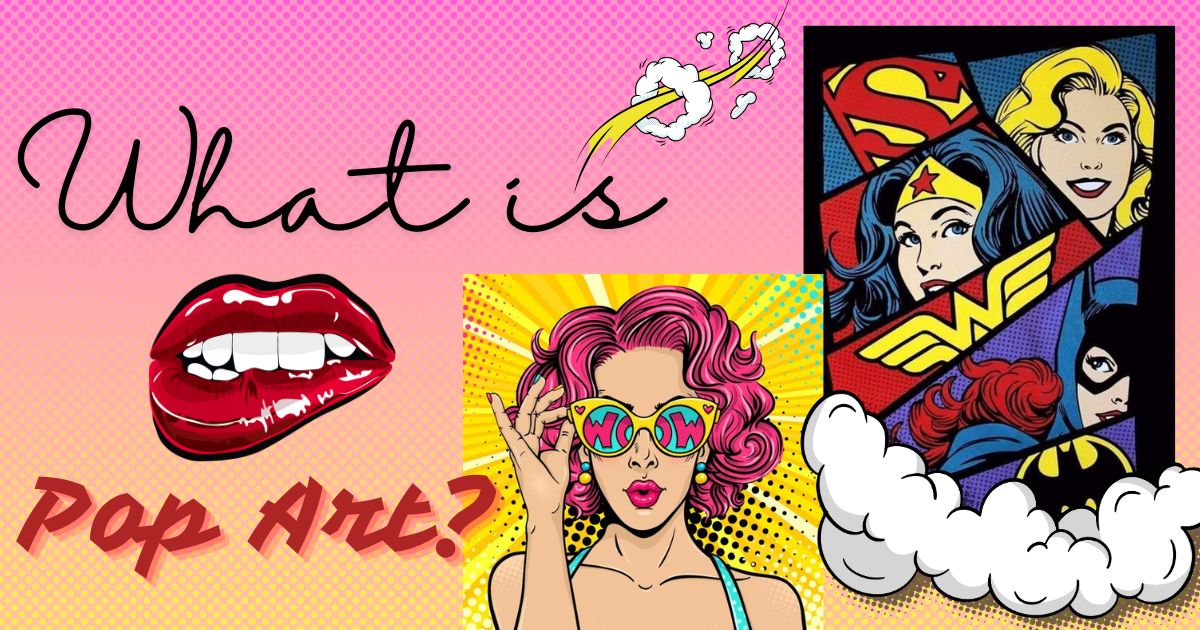
Pop Art is an influential art movement that emerged in the mid-20th century, primarily during the 1950s and 1960s, in the United States and the United Kingdom. It is characterized by its focus on popular culture and mass media, using imagery from advertising, comic books, consumer products, and everyday objects. This movement challenged traditional notions of fine art by incorporating elements from popular culture with commercial art, blurring the boundaries between high art and low culture.
A Brief History of Pop Art
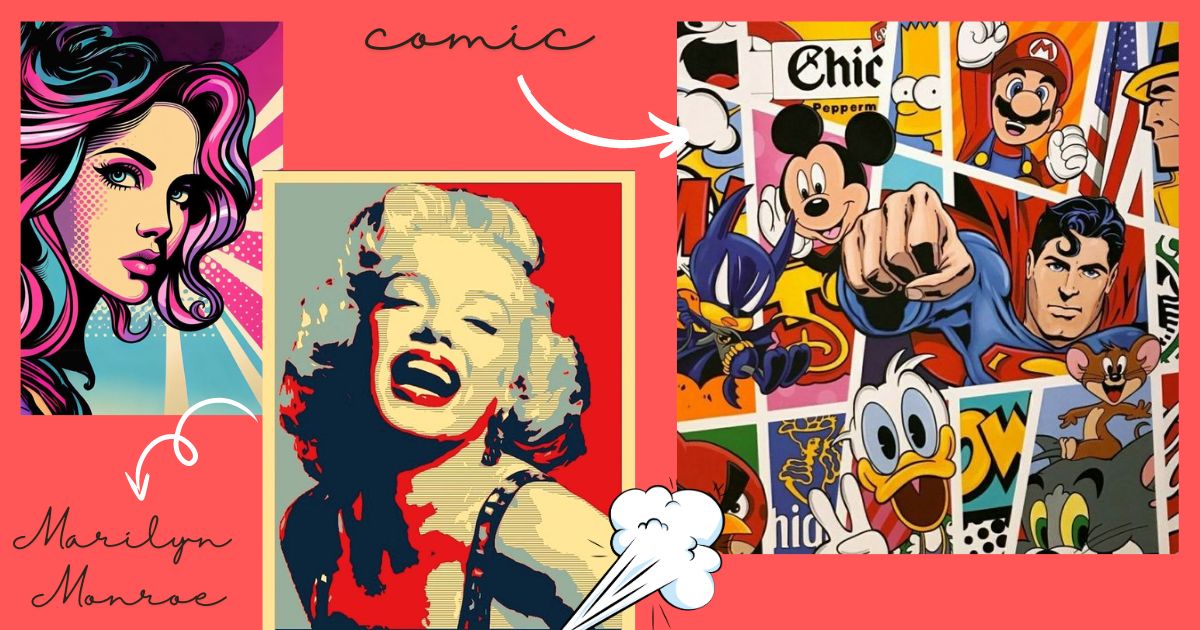
Pop Art is a significant art movement that arose in the mid-20th century, deeply intertwined with its time's social and cultural changes. Emerging during the 1950s and 1960s, Pop Art responded to the post-World War II economic boom and the rise of consumer culture. This period saw a proliferation of mass-produced goods, advertising, and media, besides, many artists felt disconnected from everyday life cause overly elitist. So, the movement emerged as a reaction against the dominant abstract expressionism.
The roots of Pop Art can be traced back to earlier movements like Dada and Surrealism, which also challenged traditional art forms, furthermore, embraced everyday objects. Artists like Marcel Duchamp, who famously exhibited a urinal as art, paved the way for Pop Art's boundary-pushing approach. Additionally, early pioneers, such as Richard Hamilton and Eduardo Paolozzi often considered the fathers of this movement. In terms of works of art, Hamilton's 1956 collage "Just What Is It That Makes Today's Homes So Different, So Appealing?" is a seminal work that encapsulates the themes of consumerism and mass media.
In the United Kingdom, the Independent Group, a collection of artists and intellectuals in London, strongly contributes to promoting the development of British Pop Art. Artists like Peter Blake, famous for his album cover for The Beatles' "Sgt. Pepper's Lonely Hearts Club Band," and David Hockney, known for his vibrant depictions of modern life, were key figures in British.
Meanwhile, in the United States, Pop Art gained prominence in the early 1960s, with New York City as its epicenter. Andy Warhol, arguably the most famous Pop artist at the time, used mass production techniques of screen printing in works "Campbell's Soup Cans" and "Marilyn Diptych" thereby, he commented on consumerism and celebrity culture. Another famous artist is Roy Lichtenstein, known for his comic strip-inspired paintings like "Whaam!" and "Drowning Girl," which used Ben-Day dots and speech bubbles to mimic commercial printing processes. In addition, we can see blurred lines between fine art and everyday objects in the work of Jasper Johns and Robert Rauschenberg.
Unique Pop Art Characteristics
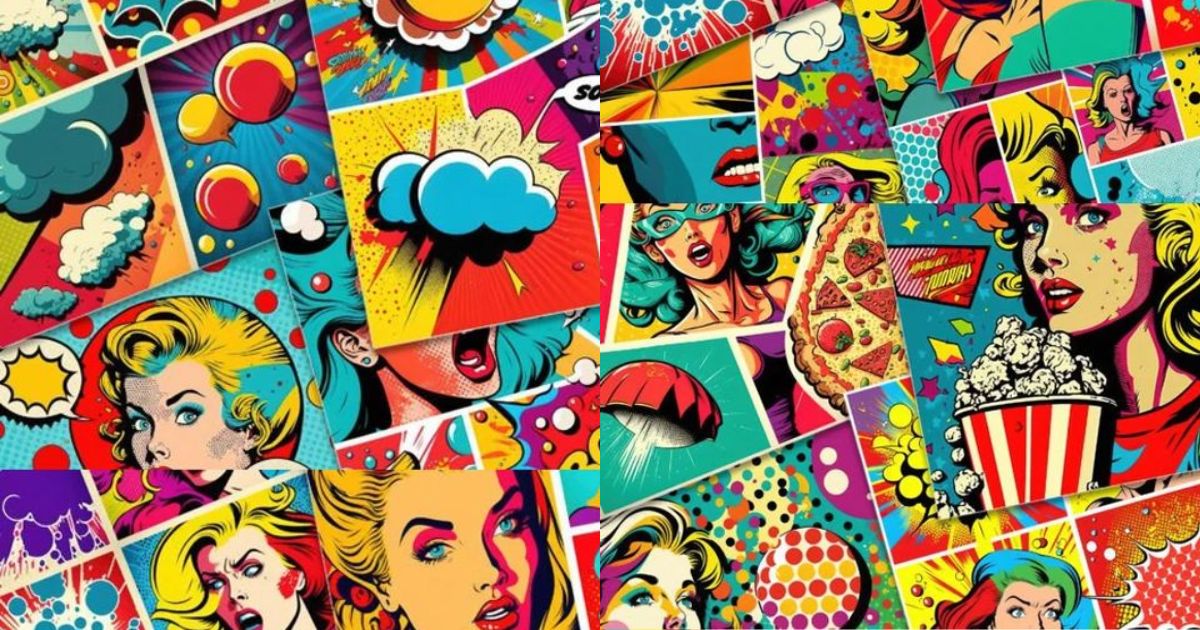
Pop Art broke the mold of traditional art by embracing bold imagery and themes directly from popular culture. Here are some key characteristics that define this art:
Use of Popular Imagery
One of the most recognizable characteristics of Pop Art is its incorporation of imagery from popular culture. Artists drew inspiration from everyday life, including advertisements, comic strips, product packaging, celebrities, and mundane objects. This use of familiar images helped bridge the gap between high art and everyday life, making art more accessible to the general public. In its path, Pop Art challenged traditional boundaries that questioned what could be considered art.
Bold Colors and Graphic Style
Pop Art is known for its vibrant and eye-catching colors, often employing a bright, saturated palette. The use of bold lines and clear graphic designs made the artwork visually striking, resulting in immediately recognizable. This graphic style was heavily influenced by commercial art, advertising, and comic books, which favored clean lines combined with stark contrasts to grab attention. Accordingly, we can see the aesthetic of this movement was both a reflection and a critique of the visual language of consumerism or mass media.
Repetition and Mass Production
Repetition and the use of mass production techniques were central to Pop Art. Artists like Andy Warhol famously used screen printing to create multiple copies of a single image, such as his series of Campbell's Soup Cans or portraits of Marilyn Monroe. This method of production mimicked industrial processes and reflected the repetitive nature of consumer goods or advertisements. Does this characteristic make you question the concept of originality in art?
Irony and Critique
While Pop Art often celebrated popular culture, it also offered a critique of consumerism, media saturation, and the commodification of art. Artists used irony and parody to comment on the pervasive influence of mass culture and its impact on society. For example, Roy Lichtenstein's comic strip-inspired paintings used the visual language of comics to explore themes of heroism and romance, often with a sense of detachment or satire. This ironic approach allowed artists to both engage with and critique the world of popular culture.
Collage and Assemblage
Some Pop Art works utilized collage and assemblage techniques, incorporating various materials and found objects into the artwork. This approach breaks the wall between high art and everyday life by bringing real-world items into the artistic space. Prominent names are Richard Hamilton and Robert Rauschenberg, who used these techniques to create complex, layered compositions that reflected the fragmented, multifaceted nature of modern life.
Cultural Reflection
Pop Art provided a mirror to the societal changes of the 20th century, capturing the essence of consumerism, mass media, and the rise of celebrity culture. The movement's artworks often showed contemporary themes, making them culturally relevant and resonant.
Integration of Text and Image
This movement frequently integrated text with images, drawing on the conventions of advertising, packaging, and comic strips. The combination of visual and verbal elements created a dynamic interplay that added layers of meaning to the artworks.
Playfulness and Humor
Many Pop Art works are characterized by a sense of playfulness and humor. The use of bright colors, exaggerated forms, and witty references to popular culture imbued the artworks with a sense of fun, even irreverence. This playful approach made art accessible and engaging, inviting viewers to see the familiar in surprising ways.
How Pop Art Changed the World
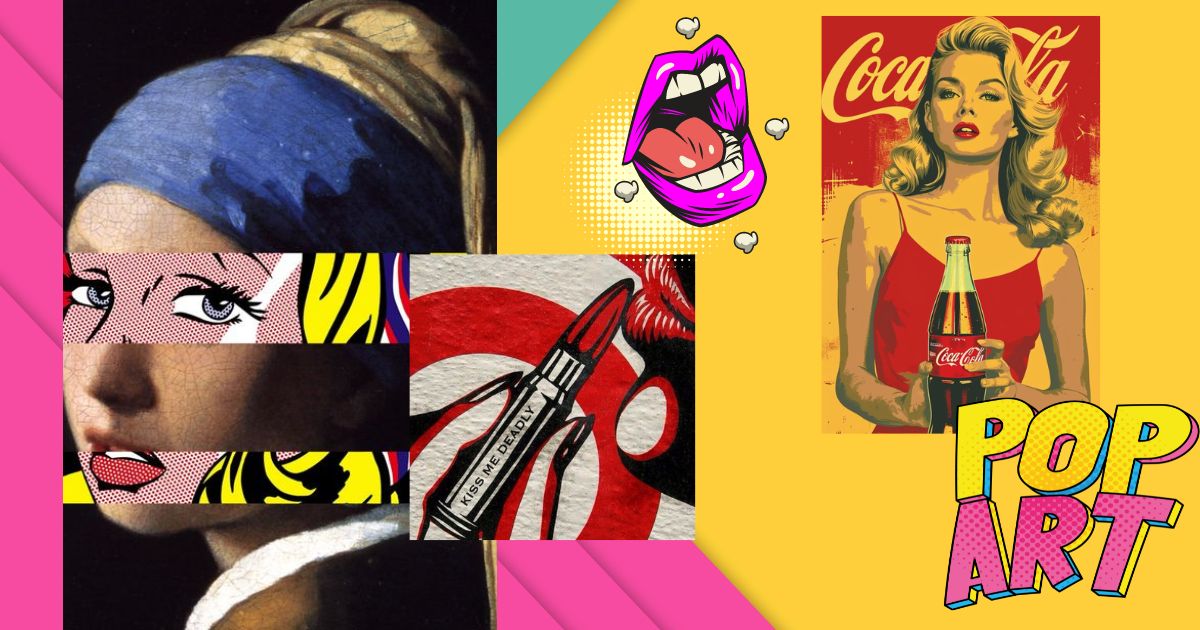
Pop Art wasn't just a splash of color on the canvas; it was a cultural revolution that reshaped how we view art and the world around us. Here's how Pop Art left its lasting mark:
Democratization of Art
Pop Art made art more accessible to the public. Suddenly, art wasn't just for museums and the elite; it was something everyone could relate to and engage with. Over and above, this movement questioned the notion that art should only reflect lofty or abstract themes, instead highlighting the artistic value of everyday objects and experiences.
Influence on Design and Fashion
Pop Art's bold colors, graphic designs, and incorporation of popular imagery have significantly influenced graphic design, advertising, and packaging. Designers cooperate with marketers to adopt the movement's aesthetic to create visually striking campaigns.
The movement's vibrant style has permeated the fashion industry. Designers like Vivienne Westwood and Moschino have drawn inspiration from Pop Art, incorporating its motifs with colors into their collections. Influence can be seen in everything from clothing, accessories to fashion photography and branding.
Cultural Reflection
Pop Art is a critical lens through which to examine the rise of consumerism and the commodification of everyday life. Artists freely highlighted the repetitive and mass-produced nature of consumer goods, prompting reflection on the impact of consumer culture.
Influence on Subsequent Art Movements
The blending of high and low culture, irony, and appropriation of existing imagery significantly influenced postmodernism. The Pop Art movement continued to challenge traditional notions of art and embraced a diverse range of styles and media.
The impact of this movement is evident in contemporary art, where artists continue to explore themes of consumerism, media, and popular culture.
Jeff Koons and Takashi Murakami are two contemporary artists who have drawn heavily on the legacy of Pop Art, employing similar techniques in their work. Their works are known for their bright colors combined with bold designs, making them visually striking to easily recognizable. They maintain the legacy of Pop Art in the contemporary art world, creating works that are both accessible and resonant with a wide audience.
Political and Social Commentary
Some pop artworks have engaged with political and social issues, using popular imagery to comment on topics such as civil rights, war, or consumerism. This tradition of socially engaged art continues today, with artists using popular culture to address contemporary issues.
The movement's emphasis on accessibility and popular culture has influenced the creation of public art. Murals, street art often draw on Pop Art's techniques to engage a wide audience and address social issues.
Global Influence
Pop Art's influence has extended beyond the United States and the United Kingdom, inspiring artists around the world. The movement's themes and techniques have been adapted to reflect local cultures or issues, contributing to a global dialogue on art.
In regions like Japan, Pop Art has been fused with local traditions and aesthetics, creating unique hybrids such as the Superflat movement led by Takashi Murakami. This cross-cultural fusion highlights the movement's versatility and enduring appeal.
Interesting Facts of Pop Art
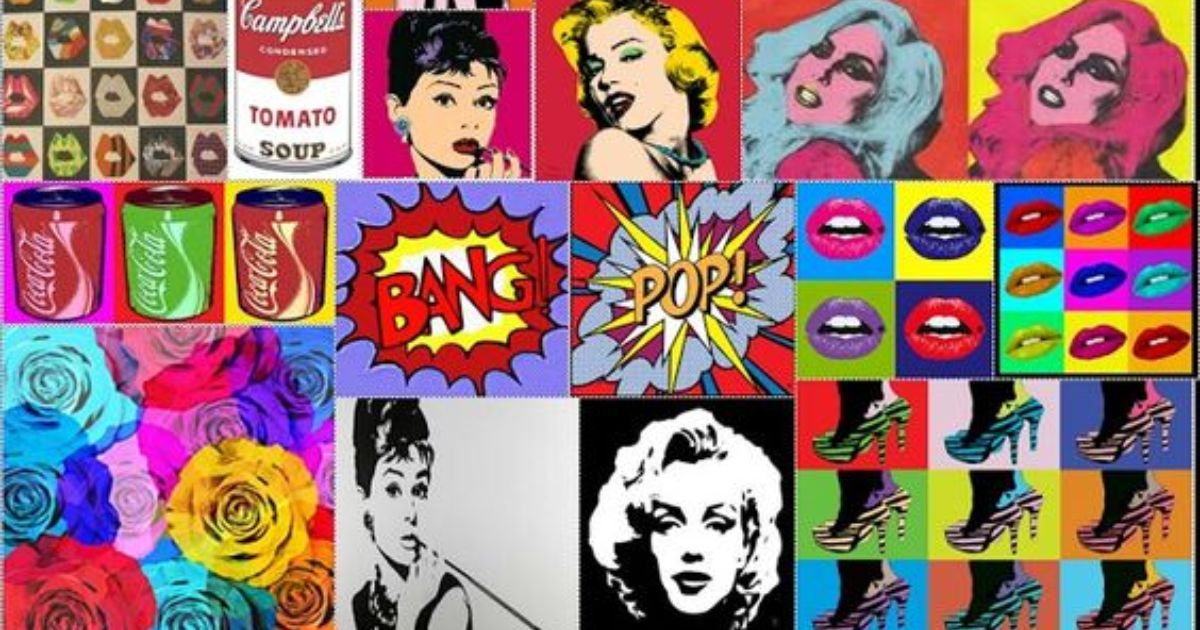
Pop Art is a fascinating and vibrant art movement. Here are some interesting facts about it:
Andy Warhol
One of the most famous Pop Art artists, Warhol is known for his iconic images of Marilyn Monroe, Campbell's Soup Cans, and Coca-Cola bottles.
Global Reach
While Pop Art is often associated with American and British artists, it also had an impact in other parts of the world. In Japan, for example, artists like Keiichi Tanaami and Ushio Shinohara produced Pop Art works.
Artistic Techniques
Pop Art artists used a variety of techniques, including silkscreen printing, collage, and painting. The movement was known for its experimental approach to materials.
Commercial Success
Pop Art was one of the first art movements to achieve significant commercial success. Andy Warhol's Shot Marilyns sold for a whopping $195 million in 2022, solidifying Pop Art's place in the high-stakes art market.
Not all Pop Art is American
While American Pop Art is widely recognized, European artists like French artist Gérard Rotella and Italian artist Mimmo Rotella also made significant contributions. They incorporated elements of European advertising and social commentary into their work.
Music and Pop Art Collide
The Pop Art movement wasn't confined to visual art. Musicians The Andy Warhol band and artist Claes Oldenburg created album covers that reflected the Pop Art aesthetic.
Beyond the Canvas
Pop Art wasn't limited to paintings and sculptures. Everyday objects were transformed into art pieces. Claes Oldenburg's Giant Lipstick (Standing Lipstick) is a prime example, challenging traditional notions of what art could be.
Enhance your expertise with Skilltrans through their curated selection of related courses. Please click on the course name below to learn more:
Cartoon Drawing For Absolute Beginners
You will learn how to draw cute cartoon characters. Also, you will learn how to draw simple cartoon backgrounds. We’ll start with the basics. For example whats the anatomy of our cute cartoon characters and what shapes we’ll use to draw them. Then we’ll jump into different facial expressions so that you can express emotion with your characters. Also different hairstyles, a lot of practice sheets, and many more.
Drawing and Colouring: Birds and Flowers (Art as Meditation)
Nature influences art in many we can't imagine art without nature. As it is the source of inspiration for every artist, its the best way to start learning art through nature. Its a kind of meditation in which we relate ourselves with the beauty of nature. When you indulge yourself in activities related to nature you feel calm and relaxed.
In this course you will learn to make beautiful leaves, flowers and exotic and beautiful birds which will not only enhance your painting.
Character Art School: Complete Coloring and Painting
Character Art School is a 6 week learn-anywhere video course where you learn to become adept at coloring and painting professional characters. I’ve hand-crafted the Character Art School: Complete Coloring and Painting course to be the only course you need, to learn all the core fundamentals and advanced techniques to coloring and painting characters well. If you’re an absolute beginner or you’re already at an intermediate level, the course will advance your current ability to a professional level. The course is a comprehensive 5 module guided video course, where the only limit to your progression is your determination and engagement in the rewarding assignments.
Conclusion
Pop Art stands as a transformative force in the world of art, bridging the gap between high art and popular culture. From Andy Warhol's Campbell's Soup Cans to Roy Lichtenstein's comic book-inspired characters, Pop Art's influence is undeniable. It showed us that art can be found anywhere, from supermarket shelves to the pages of a comic book. So next time you see a bright advertisement or a quirky design, remember the legacy of Pop Art – a movement that dared to be different and challenged us to see the world in a whole new way.
The bold colors, iconic imagery, and playful spirit of Pop Art continue to inspire artists, designers, and even everyday people today. So, if you are one of those who are passionate about this art form, sign up for Skilltrans courses today. We will lead you into a world full of impressive colors.

Meet Hoang Duyen, an experienced SEO Specialist with a proven track record in driving organic growth and boosting online visibility. She has honed her skills in keyword research, on-page optimization, and technical SEO. Her expertise lies in crafting data-driven strategies that not only improve search engine rankings but also deliver tangible results for businesses.



